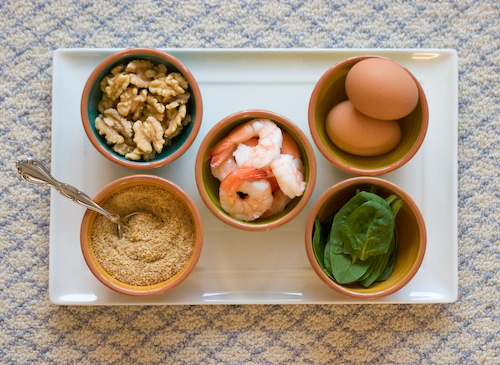

Food mistakes? We’ve made a few. You could write a book about them. Here’s the quick answer on fat: The removal of omega-3 fats to improve the shelf life of processed foods may be our worst dietary mistake. (A primer on fats is available at the bottom of this post.)
_________________________________________________________________________________________________
Fats are fascinating molecules essential to life. The industrialization of food, unfortunately, resulted in some big fat mistakes. This post provides the last of four Healthy Changes meant to improve the fats we eat. The prior changes:
• Healthy Change #2: Never buy deep fat fried foods (avoids trans fats and oxidized oils).
• Healthy Change #11: Enjoy traditional fats like butter and olive oil (in moderation).
• Healthy Change #16: Minimize consumption of refined seed oils (reduces omega-6 fat intake).
The purpose of this post is to restore omega-3 fats to their traditional place in our dietary. To appreciate the vital role of omega-3 fats in our health, here are five important lessons learned in recent decades, with credit given to the pioneers who discovered them:
Lesson #1: Two Danish scientists, Hans O. Bang and Jorn Dyerberg, studied how to prevent heart disease. In the ‘70s they decided to investigate Greenland Eskimos because they contradicted the conventional wisdom: Eskimos lived on a high-fat diet with lots of blubber, yet were free of heart disease. The scientists discovered that Eskimos (who ate more omega-3 fats) had healthy hearts while Danes (who ate more omega-6 fats, especially processed foods) had heart disease. This was revolutionary because people were wrongly being advised to replace animal fats with vegetable oils, which added to the omega-6 excess. Bang and Dyerberg’s contribution: Omega-3 (especially the form called EPA) protects against heart disease. (Note: fats are known by the acronym for the number of carbons, expressed in Greek, thus EPA and DHA, etc.)
Lesson #2: Ralph Holman, a U.S. scientist sponsored by Hormel, the maker of Spam, of all things, made the next contribution. Holman tested the blood fat profile of people around the world and made the critical discovery that omega-3 and omega-6 fats were competitive in the body. Holman’s contribution: If you eat an excess of omega-6 fats—a common problem in the Western diet—the omega-3 fats, even if you get enough, will be pushed aside. Eating both omega-3 and omega-6 is essential, but balance is critical.
Lesson #3: Dr. Michael Crawford, an English physician who studied animals in Africa, was fascinated that though body fat of animals varied with diet (not unlike humans), the fat profile in brains was remarkable constant and rich in the DHA omega-3 fat. Crawford’s main contribution: Omega-3 DHA is critical to cells involved in data processing—the brain, nerves, and eyes.
Lesson #4: Dr. William Lands studied the role of chronic inflammation—the immune system’s excessive response to unhealthy modern life—in the rise of chronic diseases like arthritis, high blood pressure, heart disease, stroke, and certain autoimmune diseases. His work led to an understanding of how inflammation is driven by omega-6 and calmed by omega-3. Lands discovery: The high ratio of omega-6 to omega-3 fat in the modern diet can cause the inflammation that leads to chronic disease.
Lesson #5: Dr. Artemis Simopoulos studied the fat profile of cultivated and wild greens and how a diet of these greens affected the fat profile of animals. Eggs from chickens whose diet included wild greens, for example, have ten-fold more omega-3 DHA than the eggs of chickens fed a typical grain diet. Lesson: Animal food products (eggs, dairy, meat) will only have a healthy fat profile if the animal is fed a healthy diet (that includes greens). This is also true for humans, by the way.
Sources of omega-3 fats are shown in the picture above. The modern deficiency of omega-3 is a little crazy: Because the ALA form of omega-3 is found in plants, omega-3s are the most common fat on the planet. So we have a classic contradiction: the modern diet is most deficient in what Nature has most generously provided. We can get our ALA by eating green plants like spinach, and foods like walnuts and flaxseed. (Try to eat a daily salad; the breakfast compote includes ground flaxseed, which can be added to many dishes.)
The body can convert ALA to the higher forms, EPA and DHA, but at a limited rate. So our diet should also include EPA and DHA, available from animal sources such as cold-water fish (or shrimp) and eggs from chickens (whose diet includes greens, flaxseed, or algae). In our home, we try to eat fish twice per week and buy eggs from well-fed chickens. If salmon or shrimp is too expensive, try sardines (which also have less mercury).

Fats have been vilified and villainized in the past but actually are essential to life. Please share your thoughts on fats in your diet, or comment on ways to reduce omega-6 and increase omega-3.
Need a reminder? Download our Healthy Change reminder card. Print and fold, then place in your kitchen or on your bathroom mirror to help you remember the Healthy Change of the week.